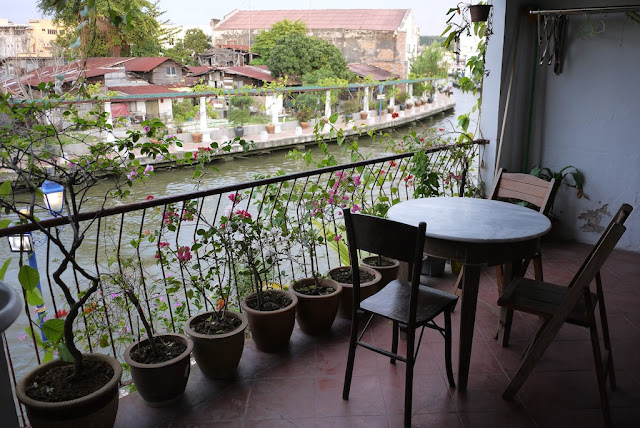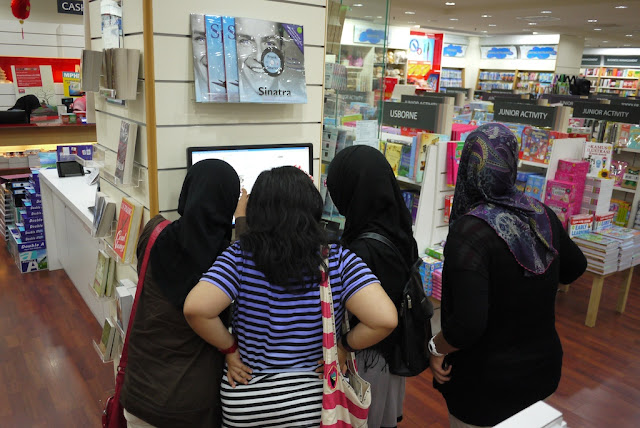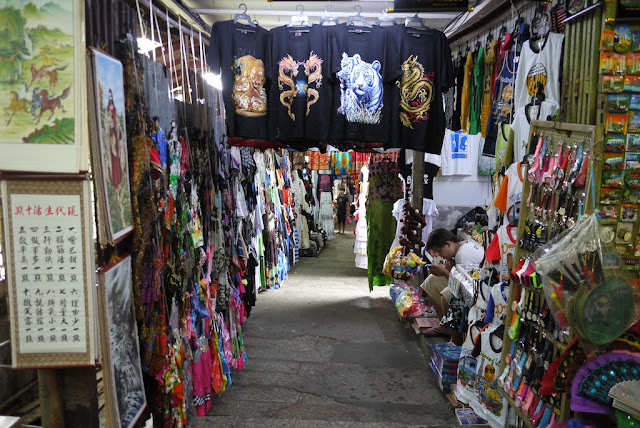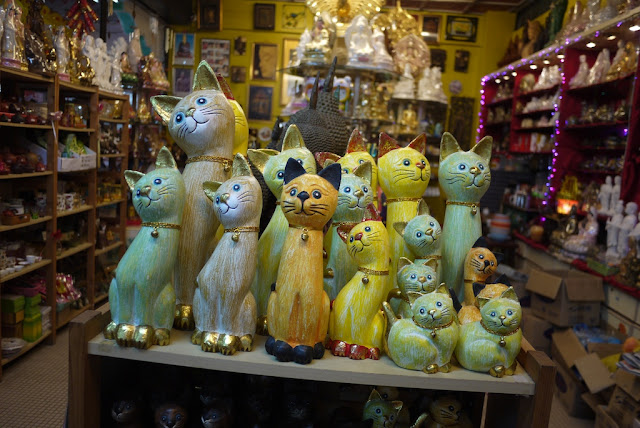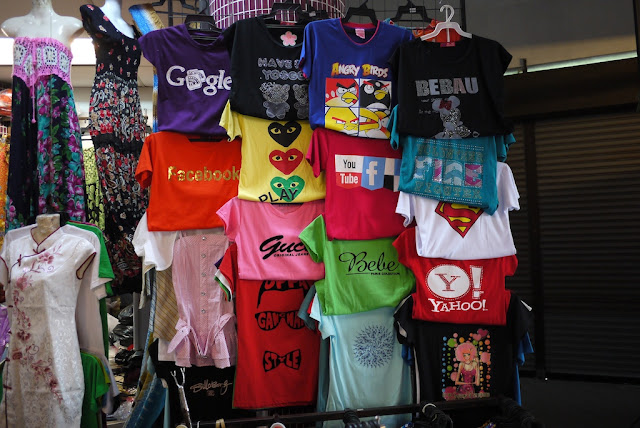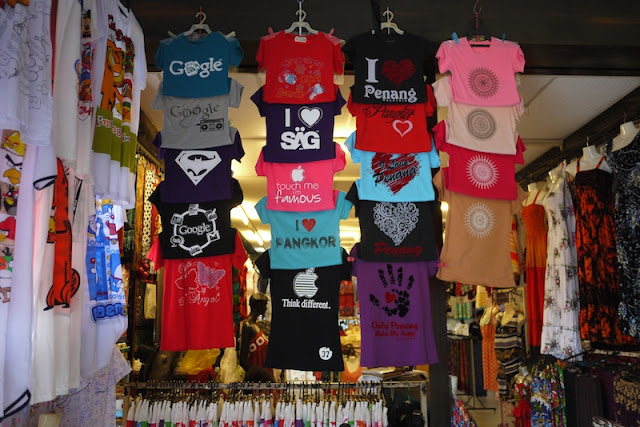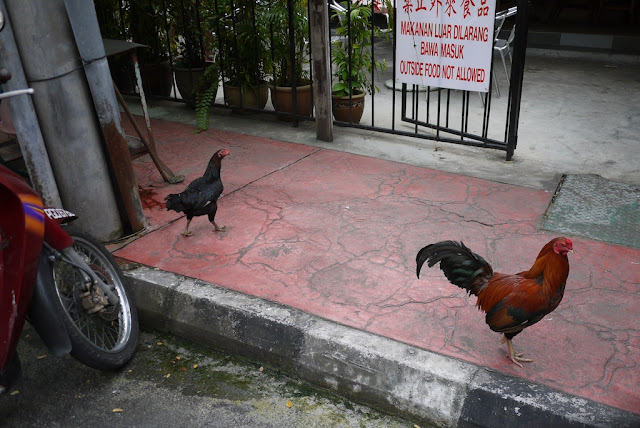Thursday, January 31, 2013
Tuesday, January 29, 2013
Signing for Love in Malaysia
Posted by
Brian Glucroft
at
7:31 PM
What's the best way to seek a boyfriend's forgiveness? One young woman in Malaysia decided the answer included collecting signatures from people in various Malaysian cities and taking photographs with them while she held a sign. When I happened to meet her today in Melaka, she already had many signatures in a previously blank book. For what was she seeking forgiveness? That didn't seem to be something she wanted to discuss.

One reason her actions caught my attention was that I could imagine a similar story playing out in China on a service such as Sina Weibo. And like the messages I saw on a bulletin board in a Changsha dormitory room, there could be important insights to gain about why she did not chose to express herself online.
Many may now be wondering if her boyfriend will respond favorably when she shares the fruits of her efforts. Without knowing more I don't think I could make a meaningful prediction. But she happily agreed to provide an update. If I hear anything, I'll pass it on.

One reason her actions caught my attention was that I could imagine a similar story playing out in China on a service such as Sina Weibo. And like the messages I saw on a bulletin board in a Changsha dormitory room, there could be important insights to gain about why she did not chose to express herself online.
Many may now be wondering if her boyfriend will respond favorably when she shares the fruits of her efforts. Without knowing more I don't think I could make a meaningful prediction. But she happily agreed to provide an update. If I hear anything, I'll pass it on.
Monday, January 28, 2013
Four Malaysian Girls and a Boy Band Book
Posted by
Brian Glucroft
at
11:55 PM
The girls in the above photo were excitedly talking to each other and giggling while using a computer at a mall bookstore in Melaka, Malaysia. They were seeking the book The One Direction Story: An Unauthorized Biography by Danny White. For readers not familiar with One Direction, according to Wikipedia:
One Direction are an English-Irish pop boy band based in London, consisting of members Niall Horan, Zayn Malik, Liam Payne, Harry Styles, and Louis Tomlinson. They signed with Simon Cowell's record label Syco Records after being formed and finishing third in the seventh series of British television singing competition The X Factor in 2010. The group subsequently signed in the United States with Columbia Records. Their two albums Up All Night (2011) and Take Me Home (2012), broke several records, topped the charts of most major markets, and generated worldwide chart-topping singles, including "What Makes You Beautiful" and "Live While We're Young".I have no deep insights to share about the popularity of boy bands. I'll just say that the above scene did not strike me as out of the ordinary for Malaysia and that minus a few hijabs it is one I could imagine commonly occurring in any U.S. city.
Propelled to international success by the power of social media, One Direction are often described as sparking the resurgence in the boy band concept, and of forming part of a new "British Invasion" in the United States.
Friday, January 25, 2013
Fingerprintless
Posted by
Brian Glucroft
at
11:30 PM

The woman in the above photo is tabulating my bill for the delicious lunch I enjoyed at her Nonya restaurant in Penang, Malaysia. In short, Nonya cuisine is a fusion of Chinese and Malaysian cooking styles.
If you ask her where she's from, she'll unhesitatingly say, "Malaysia"--not so surprising since she and her parents were born there. Her grandparents were born in China, though. And she marvels that they made the journey to a new country where their future was unknown. Her family's story of immigrating to another country and becoming a part of its culture reminded me of many families in the U.S.
When she asked where I was from, I mentioned that I used to live in Baltimore, Maryland. To my surprise, she was familiar with the city. She then excitedly told me about her visits there to see her son who works at a school rather familiar to me, Johns Hopkins University. More specifically, he works at its Applied Physics Laboratory (APL). She proudly showed me one of his published articles. I probably would need another degree to fully understand it, but I could see that his work is relevant to a variety of complex projects, including the MESSENGER spacecraft which is now circling the planet Mercury as part of NASA's explorations.
She mentioned she has traveled to places in the U.S. other than Baltimore. For example, she visited the World Trade Center in New York City before it was destroyed by terrorists. And she revisited the site when construction of the memorial there had just begun. It made a large impression on her, especially since she views the U.S. as the world's leading country.
She also told me about her arrival in the U.S. during a recent trip. It wasn't the same as her previous visit. This time, like other foreigners, she was fingerprinted at immigration. She saw it as a sign of the changes in America after the September 11 attacks. But I'm not sure she would have mentioned it to me except for a small problem. She has no fingerprints--something she attributes to years of working with her hands, although the condition can also be caused by a rare genetic mutation. Whatever the cause, her husband passed on through immigration while she was brought to another room.
As time passed without any update on her situation, she worried about missing her connecting flight. After sitting for a while not sure what would happen next, she approached one of the officials and explained her predicament. She asked how they could be concerned about an unarmed woman with proper documentation who was more than 70 years old and had visited the U.S. before without incident. So they decided to try fingerprinting her again. Not surprisingly, she still had no fingerprints. And for that reason there appeared to be doubt about whether she would be allowed to enter the U.S. After much discussion between various immigrations officials, though, they decided to let her pass through. Her husband had been patiently waiting for her, and they were able to make the next flight.
The woman from Penang told me she doesn't expect to see her son in the U.S. again. When I asked why, she told me about her recent knee surgery and her concern that the long trip might not be good for her. But she spoke in what seemed to be an uncertain voice. And after seeing the bafflement in her eyes as she told me about her experience at U.S. immigration and later asked me how a country as powerful and free as the U.S. could now become worried about someone like her, it is easy to wonder whether there isn't another reason she doesn't plan to return.
Wednesday, January 23, 2013
Another Refresher Post
Posted by
Brian Glucroft
at
11:28 PM
As I did once before, I will share a variety of older posts that are now buried by many others but may be of interest to newer readers.
1. A Most Amazing Payday in Shanghai & A Most Delicious Lunch Without Meat -- These are two stories about a young woman I met who moved to Shanghai to pursue some of her dreams. She could only marvel at how her life has improved since she was a child in southwest China.
2. Discoveries Leading to Questions: "Sansumg" Computers and Bilingual Notes in Nanning -- Here I provided a light glimpse of one of the research methods I have used for companies such as Microsoft in China. It emphasizes a key point: research is not only about finding answers. It is also about finding the right questions. I followed up this topic in the next post -- A Computer at a Hair Salon in Liuzhou, Guangxi.
3. Facebook, Taiwan, and a Waitress's Comments on Censorship in China -- This post shares an example of how knowledge about what is permissible in Taiwan can impact a Chinese person's views on censorship. Later when I was in Taiwan, I had an experience that further highlighted how Taiwan differs from the other side of the Taiwan Strait. -- Facebook Contrasts: Students in Taiwan and Mainland China.
That's all for now. For more you can find the previous "refresher post" here.
1. A Most Amazing Payday in Shanghai & A Most Delicious Lunch Without Meat -- These are two stories about a young woman I met who moved to Shanghai to pursue some of her dreams. She could only marvel at how her life has improved since she was a child in southwest China.
2. Discoveries Leading to Questions: "Sansumg" Computers and Bilingual Notes in Nanning -- Here I provided a light glimpse of one of the research methods I have used for companies such as Microsoft in China. It emphasizes a key point: research is not only about finding answers. It is also about finding the right questions. I followed up this topic in the next post -- A Computer at a Hair Salon in Liuzhou, Guangxi.
3. Facebook, Taiwan, and a Waitress's Comments on Censorship in China -- This post shares an example of how knowledge about what is permissible in Taiwan can impact a Chinese person's views on censorship. Later when I was in Taiwan, I had an experience that further highlighted how Taiwan differs from the other side of the Taiwan Strait. -- Facebook Contrasts: Students in Taiwan and Mainland China.
That's all for now. For more you can find the previous "refresher post" here.
Tuesday, January 22, 2013
Assorted Links: Tech in Southeast Asia, Car Pollution, Borders, and a Homemade Dialysis Machine
Posted by
Brian Glucroft
at
11:51 PM
There is an ever growing list of pieces that I want to comment on here. So that they all don't get stuck in a bottomless pit due to waiting for time to write the more extensive posts they deserve, I will share a few of them together along with some brief comments.
1. As recent posts here make clear, I have spent the past several weeks in Malaysia. I won't deny that its weather, food, and scenery were a draw. But I was also curious to take a closer look at a key country in a diverse region becoming increasingly relevant for tech companies--somewhat symbolized by an airport in Thailand being the most photographed location on Instagram.
Jon Russell shared his optimism for Southeast Asia in his article "Why Southeast Asia is the world’s most exciting region for startups and tech in 2013" on The Next Web. One of the challenges he mentioned for local startups particularly caught my eye:
2. Michael Dunne, president of Dunne & Company, a Hong Kong-based consultancy specializing in Asian car markets, wrote a post for the China Real Time Report about the growing contribution of cars to China's pollution and the challenges faced in reducing their impact. It raises several key issues, such as why electrical vehicles in China may be best considered as "coal-burning cars". He also addresses why a seemingly simple tactic--reducing pollution by improving the quality of fuel used by vehicles--is not so simple:
3. In FT Magazine Simon Kuper shares and comments on Valerio Vincenzo's photo essays about borders. Much of the article is about the lack of barriers today at the borders between many European countries. Kuper contrasts these open borders with the past and with today's more restrictive borders elsewhere in the world.
As I read Kuper's article and paged through Vincenzo's thought-provoking photos, I considered some borders not mentioned in the article that I have mentioned before: the border between Hong Kong and Shenzhen and the border between Macau and Zhuhai. Both of these borders are remarkable because they restrict the travel of mainland Chinese within their own country. Anyone in Switzerland or Germany can dine at a table straddling the countries' border without needing to show a passport, but mainland Chinese cannot even enter Hong Kong or Macau with only their passport and typically need a special permit (or proof of an onward flight and entry visa to another country). And I can only wish you good luck if you wish to try having a meal which spreads across the border between Hong Kong and Shenzhen.
4. In the category of "Chinese resourcefulness" is a story first reported by Chai Huiqun in China's newspaper Southern Weekly. You can read it in Chinese here. Or you can read Xinhua's English article by Hou Qiang "Homemade dialysis machine sustains uremia sufferer for 13 years":
The story reminds me of research conducted by former colleagues. I'll just say designers of medical technology can learn much from cases such as Hu, both in terms of the challenges some people face in China and how people sometimes overcome those challenges.
And that's all for this edition of assorted links.
1. As recent posts here make clear, I have spent the past several weeks in Malaysia. I won't deny that its weather, food, and scenery were a draw. But I was also curious to take a closer look at a key country in a diverse region becoming increasingly relevant for tech companies--somewhat symbolized by an airport in Thailand being the most photographed location on Instagram.
Jon Russell shared his optimism for Southeast Asia in his article "Why Southeast Asia is the world’s most exciting region for startups and tech in 2013" on The Next Web. One of the challenges he mentioned for local startups particularly caught my eye:
Society in many Southeast Asian countries values working for big companies (‘getting the lanyard’), not to mention that few startups can compete against the salary and compensation packages that multinationals and other large businesses can offer.This reminded me of some of the advantages multinational tech companies with foreign headquarters once enjoyed over local companies in China. It is remarkable how much the landscape has changed in recent years. To keep things brief, for now I will just say that what companies offer and what people seek will continue to evolve. In both respects, a growing variety can be found in China.
2. Michael Dunne, president of Dunne & Company, a Hong Kong-based consultancy specializing in Asian car markets, wrote a post for the China Real Time Report about the growing contribution of cars to China's pollution and the challenges faced in reducing their impact. It raises several key issues, such as why electrical vehicles in China may be best considered as "coal-burning cars". He also addresses why a seemingly simple tactic--reducing pollution by improving the quality of fuel used by vehicles--is not so simple:
Fuel prices are set by the state ostensibly to protect the economy – and especially the rural areas – from affordability shocks.As I've written before, although the pollution related to China's rapid growth is shared by many, the growth of wealth it represents has not been as equally distributed. "The wealthy" subsidizing (in one way or another) the costs of producing high quality fuel could be one way to acknowledge and partially address this problem. Not only would it help people who truly could not afford an increase in fuel prices, but it would help everyone breathe a little bit better. But like other potential solutions, despite some outside impressions of how China operates it is not a change that could be made with the flip of a switch.
State-owned oil companies China National Petroleum Corp and Sinopec have been reluctant to invest in world-class refineries that produce high quality fuel because doing so would increase costs that they cannot pass on to the consumer
3. In FT Magazine Simon Kuper shares and comments on Valerio Vincenzo's photo essays about borders. Much of the article is about the lack of barriers today at the borders between many European countries. Kuper contrasts these open borders with the past and with today's more restrictive borders elsewhere in the world.
As I read Kuper's article and paged through Vincenzo's thought-provoking photos, I considered some borders not mentioned in the article that I have mentioned before: the border between Hong Kong and Shenzhen and the border between Macau and Zhuhai. Both of these borders are remarkable because they restrict the travel of mainland Chinese within their own country. Anyone in Switzerland or Germany can dine at a table straddling the countries' border without needing to show a passport, but mainland Chinese cannot even enter Hong Kong or Macau with only their passport and typically need a special permit (or proof of an onward flight and entry visa to another country). And I can only wish you good luck if you wish to try having a meal which spreads across the border between Hong Kong and Shenzhen.
4. In the category of "Chinese resourcefulness" is a story first reported by Chai Huiqun in China's newspaper Southern Weekly. You can read it in Chinese here. Or you can read Xinhua's English article by Hou Qiang "Homemade dialysis machine sustains uremia sufferer for 13 years":
A sufferer of uremia for 20 years, Hu [Songwen] built his own hemodialysis machine with medical equipment, such as a blood pump and plastic tubing, that he purchased from a local market. The crude device has sustained his life since he stopped going to the hospital 13 years ago. Hu was a junior in college when he was diagnosed with uremia in 1993. After six years of medical treatment, hefty hospital bills completely depleted his family's savings.See Caixing Online here (H/T Malcolm Moore) for photos of Hu and his machine.
The story reminds me of research conducted by former colleagues. I'll just say designers of medical technology can learn much from cases such as Hu, both in terms of the challenges some people face in China and how people sometimes overcome those challenges.
And that's all for this edition of assorted links.
A Chinese View on America's Hoary President
Posted by
Brian Glucroft
at
9:37 PM
The beginning of Barack Obama's second term is newsworthy in many regions around the world. But I wonder if anyone captured it quite like Chen Zhi did for Xinhua (H/T Aaron Black). The title for the article almost says it all: "Barack Obama -- from handsome young to hoary old". And the article's beginning holds true to the title's theme:
For more on these two points, see a post on the Harvard Health Blog.
If you think Obama could make a rebound in his second term, Chen tempers such hope by closing the article with:
On that note, for more insights about why Chen might be so concerned about Obama's hoary hair, it might not hurt to read Jason Leow's article on The Wall Street Journal: "Chinese Bigwigs Are Quick to Reach For the Hair Color".
UPDATE: Michele Obama may not have liked it, but how would have Chen's story differed if Obama had gone with this look?
Barack Obama, a personable middle-aged man, inaugurated as the first African-American president of the United States four years ago with an ambitious oath -- "Yes, we can."Chen's focus on (and description of) Obama's appearance raises two issues (among many others):
However, when Obama swore in for a second term as the country's top leader on Monday, a man with eyebags, black spots and white hair stepped on the stage.
- It isn't clear whether or not the change in a US president's visual appearance over the period of time during their term would have been any different if had they not been president.
- One study found that being president had no impact on life expectancy: something one wouldn't expect to find if there was such a thing as "presidential aging".
For more on these two points, see a post on the Harvard Health Blog.
If you think Obama could make a rebound in his second term, Chen tempers such hope by closing the article with:
Whether the next four years could be easier for him remains a mystery, but it is for sure that Obama, buried in unstopping affairs at home and abroad, could never be any younger.I suppose it is hard to argue with that point. Though, I am surprised Chen didn't conclude with a pitch for Just For Men.
On that note, for more insights about why Chen might be so concerned about Obama's hoary hair, it might not hurt to read Jason Leow's article on The Wall Street Journal: "Chinese Bigwigs Are Quick to Reach For the Hair Color".
UPDATE: Michele Obama may not have liked it, but how would have Chen's story differed if Obama had gone with this look?
Monday, January 21, 2013
Tech Shirts For Sale at the Kek Lok Temple in Malaysia
Posted by
Brian Glucroft
at
4:36 PM
One can't-miss feature of the Kek Lok Temple in Penang, Malaysia, is the new numerous shops, whether those enclosing the steps to the temple's entrance...
... or those inside the temple complex.
Temple-related items were sold, but a variety of other goods could be found as well.
T-shirts appeared to be one of the more popular items to sell. Some included messages that left me curious about the design process used to create them.
In that respect, they were similar to many I have seen in China, although they had a different flavor. However, a specific set of shirts stood out to me.
I saw shirts with the Apple, Facebook, Google, YouTube, and Yahoo brands. Penang is an area with a great deal of Chinese influence, both historically and in its current culture. But in and around its most famous temple I didn't see a single shirt for a China-based technology brand such as Baidu, Sina Weibo, WeChat (Weixin), Xiaomi, Youku, or QQ. Especially since these shirts were sold in markets that target tourists, before commenting on what this might mean I would want to take a closer look at who purchases such shirts and whether these and similar shirts are sold elsewhere in Penang.
But at the very least these shirts are symbolic of the relative influence of American and Chinese technology brands in many regions outside of China--even where there are many Chinese people.
More on this topic later.
... or those inside the temple complex.
Temple-related items were sold, but a variety of other goods could be found as well.
T-shirts appeared to be one of the more popular items to sell. Some included messages that left me curious about the design process used to create them.
In that respect, they were similar to many I have seen in China, although they had a different flavor. However, a specific set of shirts stood out to me.
I saw shirts with the Apple, Facebook, Google, YouTube, and Yahoo brands. Penang is an area with a great deal of Chinese influence, both historically and in its current culture. But in and around its most famous temple I didn't see a single shirt for a China-based technology brand such as Baidu, Sina Weibo, WeChat (Weixin), Xiaomi, Youku, or QQ. Especially since these shirts were sold in markets that target tourists, before commenting on what this might mean I would want to take a closer look at who purchases such shirts and whether these and similar shirts are sold elsewhere in Penang.
But at the very least these shirts are symbolic of the relative influence of American and Chinese technology brands in many regions outside of China--even where there are many Chinese people.
More on this topic later.
Sunday, January 20, 2013
A Fusion of Architectural Styles: The Kek Lok Temple in Penang, Malaysia
Posted by
Brian Glucroft
at
11:33 PM
Yesterday, I visited Kek Lok Si (極樂寺) in Penang, Malaysia. According to Penang Travel Tips it:
[For more temple scenes, see here for some I saw in Macau, China.]
...is the largest and arguably the best known temple in Penang. It straddles a hillside overlooking the town of Ayer Itam and George Town beyond that. It is a temple that harmoniously blend Mahayana Buddhism with Taoist beliefs and other Chinese rituals, creating an amalgam that is uniquely its own...I have seen a large number of temples, yet Kek Lok stood out in several respects such as its combination of Thai, Burmese, and Chinese architectural styles, the large number of shops inside, and the inclined lift. I will say more about the shops in a later post, but first I will share some photos of scenes from the temple that capture a bit of its spirit and its mix of architecture. And there is also one photo of the inclined lift--about U.S. 66 cents per ride.
The 10-acre site was purchased in 1893, and the temple was completed in 1904. An official opening ceremony was conducted on 13 January, 1905.
For the first thirty-five years of its existence, the temple was without its iconic pagoda. Nevertheless it was already assuming a position as one of the most prestigious and renowned Mahayana Buddhist religious institution in Southeast Asia. It was only in 1927 that the iconic pagoda, today one of the most recognizable landmarks of Penang, came into being.
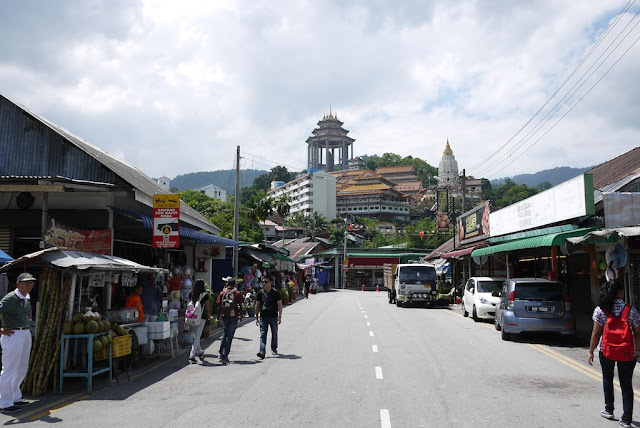 |
| Approaching Kek Lok Temple from the bus stop |
 |
| Miniature pagoda |
 |
| Full-size pagoda |
 |
| Closeup of the Pagoda of 10,000 Buddhas |
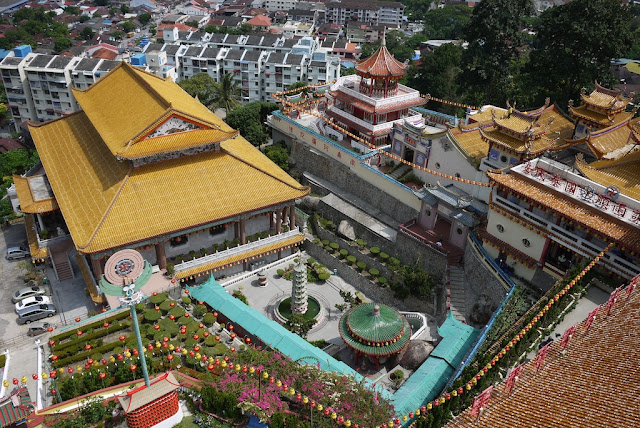 |
| A view from the pagoda |
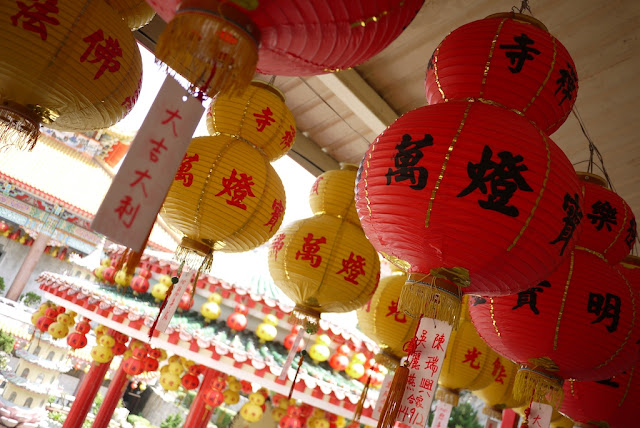 |
| Lanterns |
 |
| More lanterns |
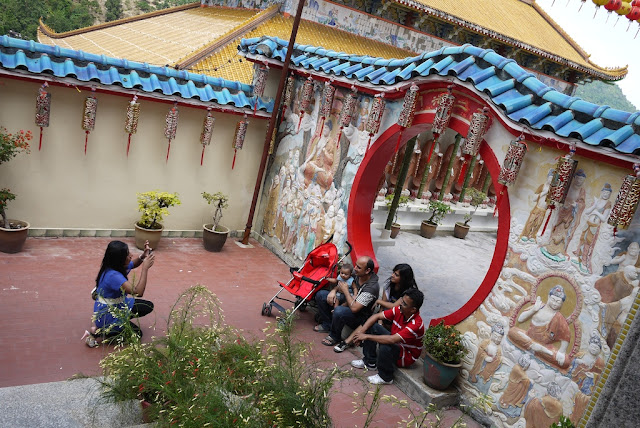 |
| Photo opportunity |
 |
| An "inclined lift" to the Kuan Yin statue |
 |
| The 30 meter tall bronze Kuan Yin statue, completed in 2002 |
 |
| Wishes |
 |
| Blessings and commemorations |
[For more temple scenes, see here for some I saw in Macau, China.]
Saturday, January 19, 2013
A Woman and Baby in Changsha
Posted by
Brian Glucroft
at
2:11 AM
A couple of months ago while taking a closer look at a street market in Changsha, Hunan province, I briefly met a woman and a baby.
Other than it being a pleasant experience, I don't have much more to say. But I do have plenty more to say about what I learned in Changsha that I have not yet covered here. Someday I will "return" to Changsha and many other places I have visited in China. But first I plan to finish some half-written posts on other topics--including a fascinating discussion I had today with Malaysian woman. She said she doesn't plan to revisit her son in the US because of her bad knee. But it sounded like she had other concerns.
More soon...
Other than it being a pleasant experience, I don't have much more to say. But I do have plenty more to say about what I learned in Changsha that I have not yet covered here. Someday I will "return" to Changsha and many other places I have visited in China. But first I plan to finish some half-written posts on other topics--including a fascinating discussion I had today with Malaysian woman. She said she doesn't plan to revisit her son in the US because of her bad knee. But it sounded like she had other concerns.
More soon...
Friday, January 18, 2013
Wednesday, January 16, 2013
A Riddle in Penang
Posted by
Brian Glucroft
at
1:10 PM
The other day while walking around in Batu Ferringhi, Penang, Malaysia, I witnessed an event related to an age-old question.
Although I can't dispute the typical answer for why the chicken crossed the road, I suspect there were other issues at play too. However, the chicken wasn't interested in talking and had protection.
Non-chicken-related posts on the way. But if you crave another chicken & rooster photo, see the earlier post "China Scenes: Villages Around Kaili, Guizhou".
Although I can't dispute the typical answer for why the chicken crossed the road, I suspect there were other issues at play too. However, the chicken wasn't interested in talking and had protection.
Non-chicken-related posts on the way. But if you crave another chicken & rooster photo, see the earlier post "China Scenes: Villages Around Kaili, Guizhou".
Subscribe to:
Posts (Atom)

